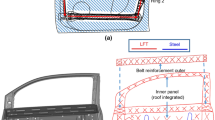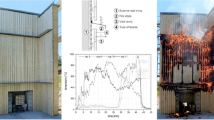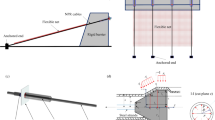Abstract
Recently, the global demand for reducing pedestrian injuries that result from vehicle accidents has increased. The lower legs of pedestrians, in particular, are more frequently injured than other parts of the body in accidents because they make direct contact with the front bumper systems of vehicles. Thus, it is necessary to reduce injuries by improving the structure of the frontal bumper. EPP (expanded polypropylene) foam is commonly used to absorb energy in a bumper system, but the foam is not sufficient to absorb the impact in the limited inner bumper space. Thus, a crumple bumper structure made from engineering plastics could be more effective in reducing the level of injury. The dynamic material properties for engineering plastics are required in pedestrian-to-vehicle collision analysis to determine the design shape for this structure. In general, it is very difficult to extract these properties. In this study, an indirect method to extract the dynamic material properties for the engineering plastics is applied: a correlation method between the falling-dart impact test and finite element analysis. Finally, an optimized plastic energy absorber is proposed to improve pedestrian safety performance by conducting a parameter study for its design values.
Similar content being viewed by others
Abbreviations
- σ :
-
static stress
- σ d :
-
dynamic hardening stress
- m :
-
strain rate hardening exponen
- \({\dot \varepsilon _p}\) :
-
plastic deformation
- D :
-
material constant
- p :
-
material constant
- \({\dot \varepsilon _r}\) :
-
strain rate
- C :
-
material constant
- t :
-
thickness
- EPP:
-
expanded polypropylene foam
- GTR:
-
global technical regulation
- UNECE/WP29:
-
united nations economic commission for europe/world forum for harmonization of vehicle regulations
- IRTAD:
-
international road traffic accident database, part of the OECD
- GRSP:
-
global road safety partnership
- BLE:
-
bonnet leading edge
- NCAP:
-
new car assessment program
- DHF:
-
dynamic hardening factor
- FEM:
-
front-end module
- CAE:
-
computer aided engineering
- GMT:
-
glass fiber reinforced thermoplastics
- LSTC:
-
livermore software technology corporation
References
Arriaga, A., Lazkano, J. M., Pagaldai, R., Zaldua, A. M., Hernandez, R., Atxurra, R. and Chrysostomou, A. (2007). Finite-element analysis of quasi-static characterization tests in thermoplastic materials: Experimental and numerical analysis results correlation with ANSYS. Polymer Testing 26, 3, 284–305.
Avalle, M., Peroni, M. and Scattina, A. (2010). Mechanical models of the behaviour of plastic materials: influence of time and temperature. Latin American J. Solids and Structures 7, 1, 41–61.
Choi, K. S., Kang, W. J., Kim, K. H. and Kim, S. K. (2009). High strain rate compression behavior of EPP bumper foams. Trans. Korean Society of Automotive Engineers 17, 4, 118–125.
Du Bois, P. A., Kolling, S., Koesters, M. and Frank, T. (2006). Material behaviour of polymers under impact loading. Int. J. Impact Engineering 32, 5, 725–740.
ECE/TRANS/132 and Corr.1 (2008). Agreement Concerning the Establishing of Global Technical Regulations for Wheeled Vehicles, Equipment and Parts Which Can Be Fitted and/or Be Used on Wheeled Vehicles. Global Technical Regulation, No. 9, Pedestrian Safety.
Gavrila, D. M. (2001). Sensor-based pedestrian protection. IEEE Intelligent Systems 16, 6, 77–81.
Jiri, S. and Martin, K. (2006). Influence of bumper design to lower leg impact response. FISITA World Automotive Cong.
Jung, E. M., Park, D. K. and Na, W. K. (2005). A Study on the Correlation Technique between FEA and Test of Europe Pedestrian Protection. Fall Conf. Proc., Korean Society of Automotive Engineers, 1730–1735.
Kang, H. S. (2007). Development of design method for a bumper cross-section satisfying protection requirements for car body and pedestrian (using CAD/CAM). J. Korea Academia-Industrial Cooperation Society 8, 5, 968–972.
Kang, W. J. and Huh, H. (2000). Crash analysis auto body structures considering the strain-rate hardening effect. Int. J. Automotive Technology 1, 1, 35–41.
Kang, W. J., Cho, S. S., Huh, H. and Jung, D. T. (1997). High strain rate tensile test of sheet metals with a new tension split hopkinson bar. Trans. KSME-A 21, 12, 2209–2219.
Kim, D. Y., Nguyen, N. T., Kim, Y. W., Kim, D. H., Kim, D. S. and Kim, H. Y. (2012). Study of mechanical characteristics and material modeling for plastics. KSAE Annual Conf. Proc., Korean Society of Automotive Engineers, 2006–2009.
Kim, H. Y., Yang, T. G., Park, S. J. and Na, W. K. (2006). Development on bumper system for a pedestrian protection regulation by engineering & design to insure the safety of pedestrians. Spring Conf. Proc., Korean Society of Automotive Engineers, 1332–1338.
Kim, K. J. and Won, S. T. (2008). Effect of structural variables on automotive body bumper impact beam. Int. J. Automotive Technology 9, 6, 713–717.
Kim, S. S., Lee, K. W. and Ahn, B. J. (2009). A study on fracture characteristics of plastics under high speed and cold temperature conditions. Spring Conf. Proc., Korean Society of Automotive Engineers, 1262–1267.
Koroad (2013). (Statics 2011) Comparison for Traffic Accidents of OECD Countries.
Lim, J. H., Kim, S. B., Kim, J. S., Huh, H. and Lee, K. W. (2004). High speed tensile tests of plastics at intermediate strain rate. Fall Conf. Proc., Korean Society of Automotive Engineers, 1390–1395.
LS-DYNA (2007). User’s Manual Ver. 971.
Moon, H. I., Jeon, Y. E., Kim, H. Y., Kim, Y. S. and Gil, H. M. (2010). Crumple zone design for pedestrian protection. KSAE Annual Conf. Proc., Korean Society of Automotive Engineers, 2214–2219.
Park, J. C. (2004). Strain rate sensitive behavior of mild steel subjected to dynamic load. KSME, 377–382.
Pedestrian Testing Protocol (2010). European New Car Assessment Programme, Version 5.2.
Teng, T. L. and Nguyen, T. H. (2008). Development and validation of FE models of impactor for pedestrian testing. J. Mechanical Science and Technology 22, 9, 1660–1667.
Author information
Authors and Affiliations
Corresponding author
Rights and permissions
About this article
Cite this article
Gil, H.M., Kwon, Y.D., Kim, D.H. et al. Minimizing pedestrian lower-leg injury considering rate dependence of the plastic energy absorber. Int.J Automot. Technol. 17, 829–841 (2016). https://doi.org/10.1007/s12239-016-0081-2
Received:
Revised:
Accepted:
Published:
Issue Date:
DOI: https://doi.org/10.1007/s12239-016-0081-2




